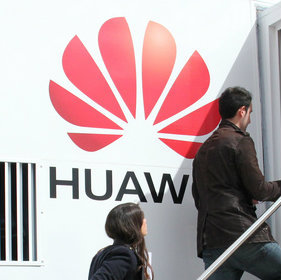
Facing a security backlash in the market for telecom network equipment, Huawei has become increasingly dependent on its non-carrier lines of business, according to Light Reading calculations based on figures disclosed at a company event in London this week.
In January, the Chinese equipment vendor revealed that sales last year reached $108.5 billion, up from $92.5 billion in 2017. Now it has shed more light on the moving parts of its huge business, and it's the consumer devices and enterprise units that have mainly been fueling growth.
So far, these divisions appear to have escaped the scrutiny of government watchdogs fretting that China could use Huawei's products to spy on other countries. But as Huawei eyes 5G deals with business customers, the risks to the company are obvious. If Huawei's 5G technology is seen as a threat in telco networks, its deployment by a bank or carmaker may be just as troubling to government authorities.
Carrier division no longer the growth engine
Although it remains a small part of Huawei, the enterprise group is becoming harder to miss. Revenues are doubling every two years, says Qiu Heng, the president of global marketing for the enterprise group, making it Huawei's fastest-growing division. In 2018, based on our calculations, sales rose to more than $10 billion, from about $8.4 billion in 2017, and Huawei expects to maintain this pace of growth until 2023. The implication is that it will be a $40 billion business by the start of that year. Next week, the enterprise group will have its own presence at the Mobile World Congress show for the first time.
Figure 1: Enterprise Ambitions  Qiu Heng, president of global marketing for Huawei's enterprise group, talks up the Chinese vendor's innovations during a company event in London this week.
Qiu Heng, president of global marketing for Huawei's enterprise group, talks up the Chinese vendor's innovations during a company event in London this week.
The Carrier division, by contrast, managed a sales increase of just 2-3% in 2018, according to Ryan Ding, the president of that unit. Using the same exchange rates Huawei applied in 2017, this would mean the company generated revenues of about $47 billion from telco customers last year. While Ding expects sales growth to improve in 2019, the carrier group he leads is no longer the standout powerhouse of Huawei's business: In 2012, it accounted for nearly 73% of total sales; by 2017, the figure had dropped to less than 50%; and it was down to just 43% last year, according to Light Reading's calculations.
Huawei's disclosures this week suggest the biggest share of 2018 revenues came from the consumer group, which makes phones, tablets and other gadgets (but mainly mobile handsets). Deduct carrier sales and $10 billion in enterprise revenues and Huawei is left with some $51.5-51.9 billion in turnover from its consumer group and "other" activities. But despite growing by nearly 29% last year, revenues from those "other" lines of business were just $2.1 billion in 2017, or 2.2% of the total.
Revenues in US$ | 2017 | 2018 |
Total | $92.6 billion | $108.5 billion |
Carrier | $45.7 billion | $46.8 billion* |
Enterprise | $8.4 billion | $10.0 billion* |
Consumer and Other | $38.5 billion | $51.7 billion* |
Source: Huawei |
5G in the enterprise, or not…
When it comes to the enterprise performance, Huawei has clearly benefited from its rapid advance into markets where historically it never had a presence. Flexing its huge R&D muscle, it claimed various "firsts" at this week's pre-MWC briefing session in London, including the world's first data center switch powered by artificial intelligence (and featuring its own Ascend 310 and Kunpeng 920 chipsets) as well as the first access point based on the new WiFi 6 standard. For enterprise customers demanding higher-speed connections with reduced signaling delay (or latency), this could hold major appeal.
But the big enterprise opportunity may lie in 5G, which promises service level and security guarantees that today's technologies would struggle to match. Indeed, many analysts think one of the most promising markets for the next-generation mobile standard is campus and factory connectivity, with 5G replacing WiFi across many enterprise environments. By taking advantage of unlicensed frequencies, or through agreements with spectrum owners, enterprises might even build their own private 5G networks.
Huawei alluded to its 5G enterprise plans in London this week. "That will happen in the future in the 5G era," said Qiu Heng when asked by Light Reading if Huawei is already developing 5G network products for enterprise customers. "In a closed campus and enterprise scenario that will be an option and we are looking to use 5G in the enterprise market."
You're invited to attend Light Reading’s Big 5G Event! Formerly the Big Communications Event and 5G North America, Big 5G is where telecom's brightest minds deliver the critical insight needed to piece together the 5G puzzle. We'll see you May 6-8 in Denver -- communications service providers get in free!
So far, any government concerns about Huawei have been largely confined to the telecom sector, according to a Huawei spokesperson. That is perhaps no surprise. Telcos are only now starting to invest in 5G infrastructure, and the concept of the private 5G network is still nascent. Access to spectrum is probably the main uncertainty in this whole area.
But should the anti-Huawei campaign intensify this year, the Chinese vendor may have to rethink its enterprise ambitions. In countries that have imposed a blanket 5G ban on Huawei, the prospect it could ever sell directly to an enterprise customer already looks remote. Other governments, however, may take a more nuanced approach, excluding Chinese vendors from some but not all parts of the 5G network. Growing interest in 5G technology from companies outside the heavily regulated telecom sector might trigger new alarm bells inside government departments.
Consumer gloom?
The other sales concern relates to the consumer group, and whether the good times can last. Unit shipments soared to more than 200 million last year, from 153 million in 2017, and revenues may have risen by as much as a third. Huawei's smartphones are now among the world's most sophisticated. And while US hostility has been a hindrance in some countries, it may be helping Huawei in China, where certain analysts think patriotic consumers have started to boycott Apple.
But the devices business is not immune to security fears stoked by US authorities. Just look at AT&T, which backed out of a smartphone deal with Huawei last year under government pressure, according to reports at the time. Moreover, the entire global smartphone market is currently running low on gas. Market research company IDC reckons smartphone shipments in China alone fell 9.7% in the final quarter of 2018, to about 103 million units, compared with the year-earlier period.
For that, blame a lengthening in the replacement cycle, say experts. Smartphones have become so advanced that new models feature only minor improvements, giving consumers less reason to upgrade. As gadget makers experiment with new form factors, and try to come up with a smartphone successor, the entire industry is feeling the squeeze. Sooner or later, it could affect Huawei too.
Related posts:
— Iain Morris, International Editor, Light Reading
About the Author(s)
You May Also Like




.jpg?width=300&auto=webp&quality=80&disable=upscale)







